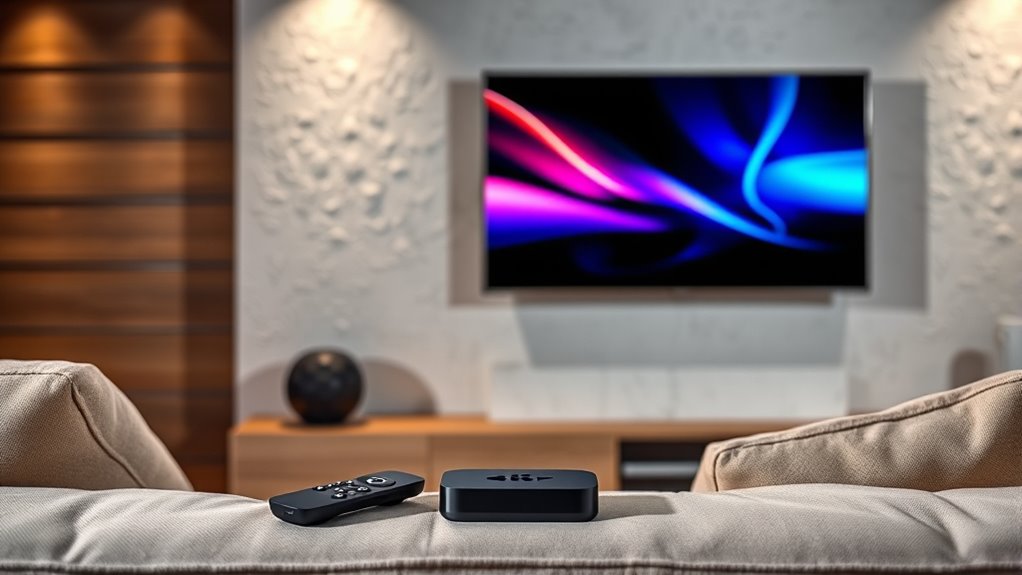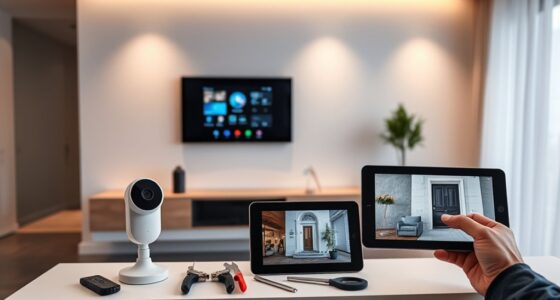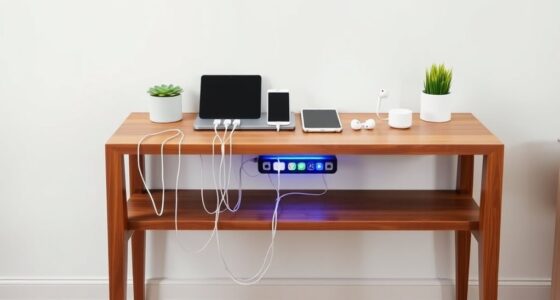If you prioritize performance, faster app launches, and access to a wide range of apps, a streaming device is your best bet. They often deliver better picture quality, smoother navigation, and regular updates, making them more future-proof. Smart TVs are simpler but may respond slower and have limited app options. Want to find out how to choose the right option for your needs? Keep exploring to get all the details.
Key Takeaways
- Streaming devices offer faster performance, quicker app launches, and more frequent updates compared to many smart TVs.
- They support a wider range of apps and enhance compatibility with the latest streaming formats.
- Streaming devices provide a more intuitive user interface and better voice control features.
- External devices often deliver superior picture and sound quality, including 4K, HDR, and Dolby Atmos support.
- Cost-effective streaming devices can upgrade existing TVs, while smart TVs may have limited app support and slower response times.

When choosing between streaming devices and smart TVs, understanding their differences can help you make the best decision for your entertainment setup. Performance and speed are key aspects to consider. Streaming devices usually pack faster processors than many smart TVs, which means apps launch quicker and navigation feels smoother. While smart TVs have improved their operating systems, some lower-end models still lag or respond slowly. High-end streaming devices like Google TV Streamer and Apple TV 4K incorporate advanced AI features, making content interaction more responsive and intuitive. Plus, these devices tend to receive more frequent software updates, keeping performance optimized and security current. On the other hand, older or budget smart TVs may suffer from sluggish response times due to weaker hardware or outdated software, which can frustrate your viewing experience.
Streaming devices offer faster processors and smoother navigation, while budget smart TVs may respond slowly and lag.
Content availability and app support also differ markedly. Streaming devices support thousands of apps, including all major streaming services like Netflix, Hulu, Amazon Prime, and YouTube TV. They often offer a broader app variety than some smart TV platforms, especially niche or newer apps. Devices such as Roku and Google TV support over 6,500 Android TV apps, greatly expanding your content options. Smart TVs come with built-in app stores, but their selection can be limited, and some models might not support all the latest or niche apps available on dedicated streaming devices. Additionally, streaming devices tend to receive faster updates that enhance app functionality and introduce new platforms more quickly than many smart TVs, giving you access to the latest content options.
When it comes to user interface and experience, streaming devices usually offer a consistent, user-friendly interface designed for quick access and customization. They come with remotes tailored for media control, providing shortcuts and search features that make navigation easy. In contrast, smart TV interfaces vary widely based on brand and model, and some may feel cluttered or less intuitive. Voice control and AI assistants, like Google’s Gemini AI on Google TV Streamer, further streamline interaction, making browsing and searching more natural. While smart TVs often integrate additional features like smart home controls, this can sometimes complicate the interface, making it less straightforward for everyday media use.
Picture and sound quality are vital for a premium viewing experience. Many streaming devices support 4K UHD, HDR, Dolby Vision, and Dolby Atmos, ensuring high-quality audio and visuals compatible with most modern TVs. Although the TV’s panel largely determines picture quality, external streaming devices ensure that the streaming format supports the best possible quality. Premium devices like NVIDIA Shield TV Pro are optimized for better video processing and gaming, often delivering superior overall performance. Keep in mind that built-in smart TV apps may not always stream in the highest quality due to hardware or software limitations. External streaming devices allow you to upgrade your streaming setup without replacing your entire TV, providing a more flexible and future-proof solution.
Price and cost efficiency vary as well. Budget-friendly options like Roku Streaming Stick Plus cost around $30 to $50, making them accessible for most budgets. Overall, your choice depends on your priorities—whether it’s faster performance, broader app support, better user interface, or superior picture quality.
Frequently Asked Questions
Can Streaming Devices Improve Picture Quality on Older TVS?
You wonder if streaming devices can boost picture quality on older TVs. They can help, but only if your TV supports standards like 4K, HDR, or Dolby Vision. A good streaming device can upscale content and improve clarity, but it won’t turn an old, low-resolution TV into a 4K display. For the best results, verify your TV is compatible with the device’s features, and consider upgrading if picture quality is a priority.
Do Smart TVS Come With Built-In Voice Assistants?
Yes, many smart TVs come with built-in voice assistants like Alexa, Google Assistant, or ThinQ AI. This means you can control your TV, search for content, and manage smart home devices hands-free without needing external devices. You just need to check your TV model’s specifications to see which voice assistant it supports. This integrated feature makes using your TV more convenient and enhances your overall entertainment experience.
Are Streaming Devices Compatible With All TV Brands?
Streaming devices are compatible with most TV brands, as long as your TV has an HDMI port. You don’t need a smart TV for them to work; simply connect the device via HDMI, and you’re set. They’re versatile and work with various brands, making them a great option if you want to upgrade your TV’s streaming capabilities without changing the entire unit. Just check for HDMI compatibility before purchasing.
Which Option Offers Better Parental Controls?
You want better parental controls, so consider your options. Smart TVs generally offer more thorough restrictions, covering all content like broadcast TV and streaming apps, and are easier to manage across the entire device. Streaming devices excel at service-specific controls, but often require extra setup. If you prioritize broad, device-wide control, a smart TV might be your best choice. For detailed control over individual streaming services, a streaming device works well.
How Do Streaming Devices Affect Internet Bandwidth Usage?
Your internet bandwidth can vanish faster than a blink of an eye when streaming—devices like Roku or Chromecast boost usage based on resolution and quality. You might not notice it at first, but streaming in HD or UHD can gobble up several gigabytes per hour. To keep your connection smooth, you should regularly monitor your data, lower quality settings, or upgrade your internet plan if needed.
Conclusion
Choosing between streaming devices and smart TVs is like picking the right tool for a job—you want what fits your needs best. If you value flexibility and upgrades, a streaming device is your trusty sidekick. If simplicity and all-in-one convenience matter more, a smart TV is like a reliable companion. Either way, you’re crafting your perfect entertainment setup, like painting a masterpiece—you just need the right brush. Your ideal choice makes your viewing experience truly shine.










